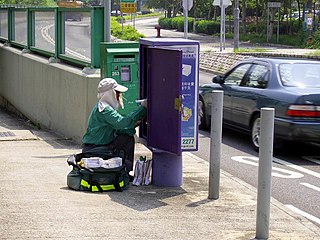
A post office is a public facility and a retailer that provides mail services, such as accepting letters and parcels, providing post office boxes, and selling postage stamps, packaging, and stationery. Post offices may offer additional services, which vary by country. These include providing and accepting government forms, and processing government services and fees. The chief administrator of a post office is called a postmaster.

The mail or post is a system for physically transporting postcards, letters, and parcels. A postal service can be private or public, though many governments place restrictions on private systems. Since the mid-19th century, national postal systems have generally been established as a government monopoly, with a fee on the article prepaid. Proof of payment is usually in the form of an adhesive postage stamp, but a postage meter is also used for bulk mailing.

NZ Post, shortened from New Zealand Post, is a state-owned enterprise responsible for providing postal service in New Zealand.

Singapore Telecommunications Limited, commonly known as Singtel, is a Singaporean telecommunications conglomerate, the country's principal fixed-line operator and one of the four major mobile network operators operating in the country.

Australia Post, formally known as the Australian Postal Corporation, is a Commonwealth government-owned corporation that provides postal services throughout Australia. Australia Post's head office is located on Bourke Street, Melbourne, above the Bourke Street Post Office.

Jersey Post is the licensed universal service provider of mail service for the Bailiwick of Jersey.

India Post is an Indian government-operated postal system in India, and is the trade name of the Department of Post under the Ministry of Communications. Generally known as the Post Office, it is the most widely distributed postal system in the world. Warren Hastings had taken initiative under East India Company to start the Postal Service in the country in 1766. It was initially established under the name "Company Mail". It was later modified into a service under the Crown in 1854 by Lord Dalhousie. Dalhousie introduced uniform postage rates and helped to pass the India Post Office Act 1854 which significantly improved upon 1837 Post Office act which had introduced regular post offices in India. It created the position Director General of Post for the whole country.

Hongkong Post is a government department of Hong Kong responsible for postal services, though operated as a trading fund. Founded in 1841, it was known as Postal Department or Post Office before the handover of Hong Kong in 1997. It has been a sub-member of the Universal Postal Union since 1877, and is a separate entity from China Post.
The Infocomm Media Development Authority (IMDA) is a statutory board under the Singapore Ministry of Communications and Information (MCI).

Russian Post is an Aktsionernoye Obschestvo which is the national postal operator of Russia. The company is responsible for the delivery of mail in Russia, and the issuing of postage stamps. Russian Post employs about 390,000 people and has over 42,000 post offices, with its headquarters in Moscow. In 2012 the Russian Post delivered more than 2.4 billion pieces of mail and accounted for more than 54 million parcels and more than 100 million in remittances. In March 2013 a presidential decree signed by President Vladimir Putin included the Russian Post in a list of so-called strategic enterprises.

Pos Malaysia Berhad is a postal delivery service in Malaysia, with history dating back to early 1800s.
Pakistan Post is a state enterprise which functions as Pakistan's primary and largest postal operator. 49,502 employees through a vehicle fleet of 5,000 operate traditional "to the door" service from more than 13,419 post offices across the country, servicing over 50 million people. Pakistan Post operates under the autonomous "Postal Services Management Board" to deliver a full range of delivery, logistics and fulfillment services to customers.

U.S. Special Delivery was a postal service paid for with additional postage for urgent letters and postal packets which are delivered in less time than by standard or first class mail service. Its meaning is different and separate from express mail delivery service. Essentially it meant that a postal packet was delivered from a post office to the addressee immediately once it arrived at the post office responsible for delivering it, rather than waiting for the next regular delivery to the addressee.

La Poste is a postal service company in France, operating in Metropolitan France, the five French overseas departments and regions and the overseas collectivity of Saint Pierre and Miquelon. Under bilateral agreements, La Poste also has responsibility for mail services in Monaco through La Poste Monaco and in Andorra alongside the Spanish company Correos.

Thailand Post (THP), formerly part of the Communications Authority of Thailand until 2003, is a state enterprise that provides postal services in Thailand.

The Department of Posts, functioning under the brand name Sri Lanka Post, is a government operated postal system in Sri Lanka. The postal headquarters is the General Post Office which is located in Colombo. The department itself comes under the purview of the Ministry of Information and Mass Media. It was formerly known as the Ceylon Post and Telecommunications Department and is one of the oldest Government departments in existence today.

HP-Hrvatska pošta d.d., founded in 1999, is a state-owned joint-stock company in Croatia that performs postal and payment transactions. It is the national postal operator of the Republic of Croatia.

Postage stamps and postal history of Singapore surveys postal history from Singapore and the postage stamps issued by that country and its various historical territories until the present day. Postal service in Singapore began with the delivery of stampless letters whose cost was borne by the receiving person, later encompassed pre-paid letters carried by private mail carriers and provisional post offices, and culminated in a system of universal prepayment that required all letters to bear nationally issued adhesive postage stamps. Singapore is an island country off maritime Southeast Asia, located between the Straits of Malacca and the South China Sea.

This is a survey of the postal history and postage stamps of Thailand.

The Government Technology Agency (GovTech) is a statutory board of the Government of Singapore, under the Prime Minister's Office. It was restructured from Infocomm Development Authority of Singapore (IMDA) in 2016, and officially legislated in Parliament on 18 August that year.





















